
“A Private War” composer H. Scott Salinas and songwriter Annie Lennox speak at the Variety Music for Screens Summit. (Photo: Paula Parisi / MaxTheTrax)
Annie Lennox can afford to be choosy about her projects these days. After winning the Oscar with “Into the West” for Peter Jackson’s 2003 film The Lord of the Rings: Return of the King, Lennox has had no shortage of offers, most of which she seems to turn down. But when the call came to create a song for A Private War, the story of war correspondent Marie Colvin, the artist was taken somewhat by surprise. It had been seven years since she’d written a song. “Before I came back with an answer I tried to see if a song would come to me. I went to the keyboard, and it was almost like a tarot pack or something. It was very strange. I got goosebumps and I thought, I’m on to something,” Lennox told the crowd at Variety’s Music for Screens Summit.
The result, “Requiem for a Private War,” is a denoument both mournful and healing over the end credits of the film, directed by Matthew Heineman and released this month by Aviron Pictures. A Private War: Original Motion Picture Soundtrack was released digitally and on CD by Music.Film Recordings and includes Lennox’s song as well as the score by composer H. Scott Salinas, (Just Friends, Edison), who co-produced “Requiem.”
Lennox explained how in her experience, writing music is foremost an emotional exercise. “Intellect comes afterwards. First is intuition; So I intuited some chords and some statement came through. I had a picture in my head of Marie and what happened at the end of her life, and it was powerful,” Lennox said in a chat with A Private War composer H. Scott Salinas at NeueHouse in Hollywood, Oct. 30.
It just so happened that Lennox had actually met Colvin at an event for The Circle, a small NGO formed by Lennox in 2008 to help women in impoverished and war-torn countries. “Marie came to one of our events, years ago. And she loved what we were doing,” Lennox said. “We had a nice conversation, and I was so happy she was there. It was like, I get you. You get me,” Lennox told the sold-out crowd, in a conversation moderated by Variety contributor James Patrick Herman.
Colvin, an American journalist, was instantly recognizable by the trademark black patch over her left eye, rendered sightless by a shrapnel injury she sustained covering the Sri Lankan war in 2001. She is played in the film by Rosamund Pike in a widely praised performance that seems destined to make the actress an awards season contender. Colvin was 56 when she was killed in Syria in 2012 by a nail bomb. Her family is suing the Syrian government over what it claims was a targeted assassination by the regime of Bashar al-Assad, part of a coordinated effort “to impose an information blackout by neutralizing professional and citizen journalists in the country who were reaching an international audience.” Twenty-eight-year-old French photographer Rémi Ochlik was also killed in the attack.

Prior to her death in 2012, war correspondent Marie Colvin (right) talks with Camillla Parker Bowles, Duchess of Cornwall at a reception. (Photo: Matthew Edwards/AP)
“When she was killed it was very shocking to everyone who knew her. Even knowing the risks, whether it’s a soldier or a correspondent, it’s devastating,” Lennox said, driving home the realities of war. “Marie was trying to get at the truth about the bombing in Homs, that civilians were being targeted. They weren’t just going after the rebels.’ Marie was there. She witnessed it. She was writing it down and wanted the messaging out.” Colvin suffered from alcoholism and PTSD as a result of what she’d seen, all of which is covered in the film.
In addition to being the story of Colvin’s life the story is also about the truth of the horrors of war, Lennox movingly explained. “Thousands of people could die with one to witness it and no one to care. Who is going to change that circumstance? If Marie was here today that’s what she would want to tell you. And six years later, nothing has changed. We’ve got more refugees around the world now than we’ve had at any time in history. It’s appalling.”
Salinas recalls he and Heineman both breaking into tears the first time Lennox demoed the song “Requiem for a Private War” for them on piano. “Annie said, ‘I’ve got a few ideas,’ and we look and it’s all written out in sheet music. Annie’s a fully trained composer, so it’s fully notated, these different sort of ideas that were just different parts of the same song. And she said, ‘If it’s okay, I’m just going to play it for you.’ And Matt and I are literally next to her crying. Because it’s so on point, the song, and we were overwhelmed by the situation. And Annie looked at me at one point and said ‘I’m sorry I know I rushed that a little bit.’ We left singing the song. We wanted to get the hell out of there – we couldn’t believe we hadn’t messed this thing up!”
Lennox surged to international fame in the ’80s as as half of the pop ensemble Eurythmics, and her rich, contralto voice is one of the most recognizable in the world. Salinas described how in addition to singing the lyrics “Requiem for a Private War” has “some instrumental hooks” that are performed by Lennox. There are wind-like sounds performed by Lennox, as are some of the percussive rhythms. “There’s a point where the song really builds to a rhythmic climax, mostly at the end — a shooka-shooka-shooka-shooka-shook — that’s literally Annie hyperventilating as the rhythm of the end of the song, , and we added the sounds of metal smashing and some bombs.” Salinas said the goal was to give the rhythm an organic feel as opposed to something created by a beat box. “I think we both knew where that line was.”
In writing “Requiem for a Private War” Lennox said she was referencing 17th century British composer Henry Purcell. “Purcell wrote an incredible soliloquy, ‘Dido’s Lament,’ that was part of [the opera] Dido and Aeneas. That song has a lamenting quality that you’d give after a terrible death, a terrible tragedy. I feel the song works in this way and it also helps to kind of cradle the audience after they see the film, because it is harrowing and deeply upsetting, and the audience needs a moment to breathe.”
Salinas, a Princeton University-trained jazz musician, says the song serves a dual purpose of call to arms — “bring it on, you know? [Marie’s] relentless thirst for the truth and willingness to risk her life” — while at the same time offering comfort. For his part, he found a voice for the score in “this concept of being underwater and feeling the current, that feeling of being pulled out by the undertow and the waves crashing in on you. Getting pulled, then coming up for air and getting smashed on. That’s what I felt her struggle was like, so we applied that directly into the music by taking organic sounds, like a flute, which is a pretty, lovely sound, and then processing it and maybe playing it at varying speed, like when you put your finger on a record player to slow it down. Now it’s this big sound and it kind of sounds underwater and we just started trying to think of ways to create this pull and this underwater and when you come up for air that explosive feel. That’s what the score is.”
The idea was to have a score that would help capture Colvin’s point of view. “As opposed to trying to be incredibly authentic to the region I embraced the fact, much like Marie, that this is from my own Western perspective,” Salinas said. “That had flaws, but I wasn’t going to try to deny it.” In one example, he uses a mandolin in place of an oud, a classically Eastern instrument. “A mandolin is a bluegrass instrument, but it started to take on this ethnic quality when we manipulated it.” Salinas admits that as with so much on indie films, necessity was often the mother of invention. “My oud player had gone on tour, and I’m a guitar player. A mandolin is like a mini oud in terms of the way it sounds, and an oud is sort of a Middle Eastern guitar. Again, when you pitch it down or vary-speed it, it takes on a lot of the same properties. We found that really interesting. “
“It’s so interesting when you’re creating music with other people, and you have a connection with them, and you can trust each other,” Lennox said. “There is a landscape that you’re sharing together, and you see it together. Music is a language. An extraordinary language.” While Lennox may still partake of the occasional songwriting session, and still plans to make music, these days her life is so much more. “I’m so, so passionate about activism. I don’t want to be an entertainer. I don’t want to go on the road and sing songs that people know. I mean, it’s a great privilege to write songs that everybody knows, and if you sing them night after night, that’s fantastic. I don’t want to do it anymore.”
One of the things Lennox has done is join forces with Colvin’s family and friends to create a heritage the fallen reporter’s honor, so the Marie Colvin Journalists Network was launched through The Circle. The MCJN mentors and supports young female war correspondents in the Middle East. “In this time where people are talking about ‘untruthiness,’ or ‘fake news’ or whatever, there are journalists who are risking their lives every day, going out in the most appalling human-made situations of violence and warfare. While they may go and cover natural catastrophes and disasters, war is made by mankind.”
Click to hear A Private War on Spotify. Track list:
1. Fear Comes Later (3:12)
2. Marie’s Lost Theme (1:41)
3. Sunday Times (1:51)
4. Sri Lanka (1:12)
5. Marjah (1:39)
6. Marie Loses Her Eye (2:21)
7. Nice Eyepatch (1:57)
8. Mass Graves (1:50)
9. The End is Near (2:15)
10. The Search for Truth (2:04)
11. Bombs (5:03)
12. Eulogy (1:41)
13. Norm Dies (1:48)
14. Return to the Tunnel (1:45)
15. The Final Broadcast (4:01)
16. Requiem for a Private War – Annie Lennox (6:34)


Comments are closed.